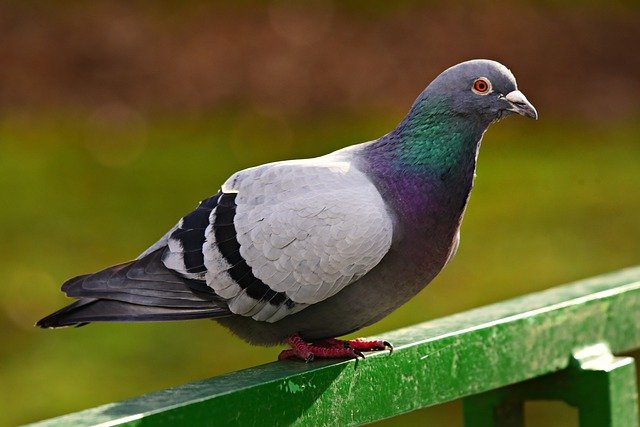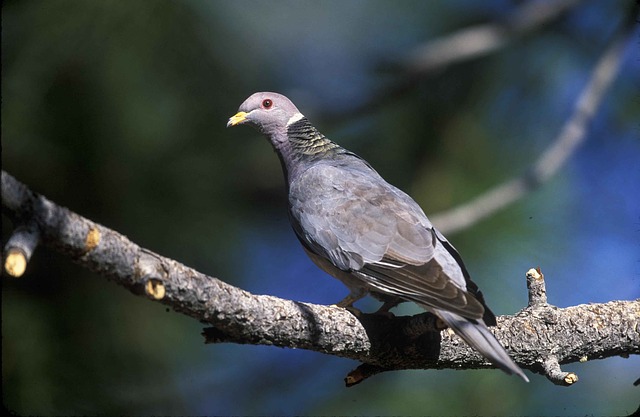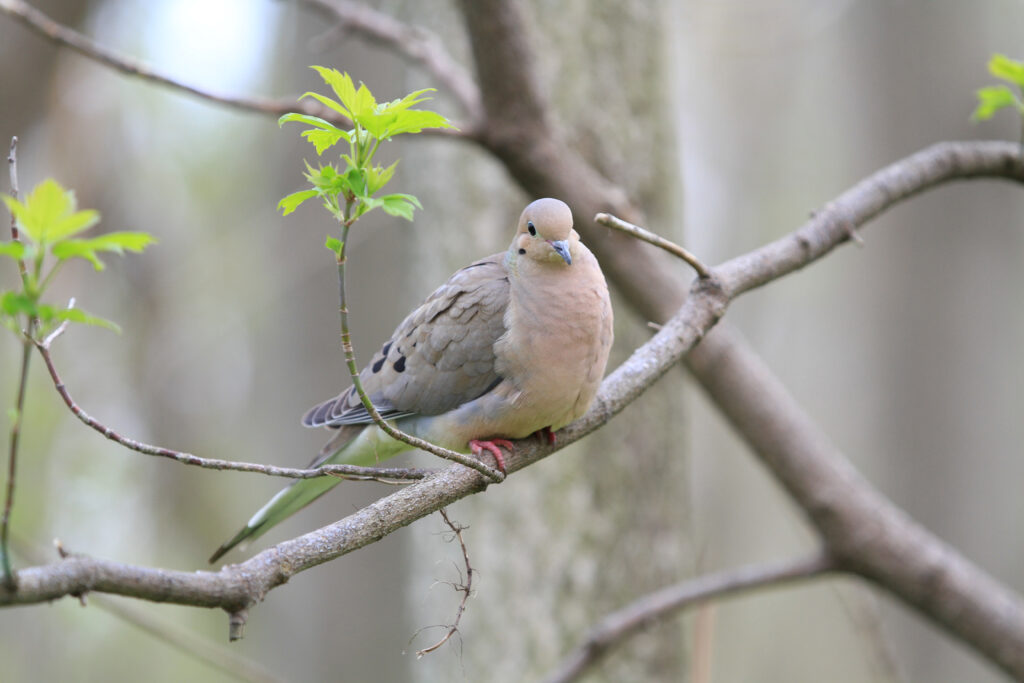From the mournful coo of the Mourning Dove to the distinctive call of the Eurasian Collared-Dove, Colorado is home to a diverse array of dove species.
These graceful birds, known for their soft feathers and gentle flight, add to the natural beauty of the state.
In this article, we explore 5 must-see types of doves found in Colorado, each with its own unique characteristics and behaviors that make them truly one-of-a-kind.
| Image | Name |
|---|---|
 | Rock Pigeon |
 | Mourning Dove |
 | Eurasian Collared-Dove |
 | Band-tailed Pigeon |
 | White-winged Dove |
Types of Doves in Colorado
1. Rock Pigeon

Rock Pigeon is a chubby bird with short legs, a narrow beak, and a head that is proportionately smaller than its body.
The back of a normal pigeon is grey, its head is blue-grey, and it has two black stripes on its wings.
However, the coloration of their plumage may range from completely white to rusty brown, and it is not uncommon to see examples of both.
Rock Pigeons are among the most abundant doves in the state of Colorado, yet, they are nearly never seen outside of human settlements.
These are the birds that everyone means when they talk about pigeons.
You have most likely seen them congregating in large numbers in city parks in the hope of receiving some birdseed or leftover food to be thrown at them.
Pigeons are readily drawn to bird feeders, particularly if there is food that has been dropped to the ground and is still edible.
When they flock to your garden in large numbers, though, these birds may become something of an annoyance and cause damage.
A lot of individuals think that being in their company is exhausting; therefore, they search for methods to get away from them.
These birds are simple to recognize based on their calls. My hunch is that you are already familiar with the gentle, throaty coos that they make.
Since the beginning of time, people have had a close relationship with Rock Pigeons.
There is evidence in the form of Egyptian hieroglyphics that suggests humanity began to domesticate them more than 5,000 years ago.
And as a consequence of these facts, experts don’t even know for certain where their initial range was.
2. Mourning Dove

A dove that is mostly grey in color and has huge black dots on the wings, as well as a long and narrow tail.
Be on the lookout for a black beak, pink legs, and an eye ring that is distinctly blue.
Both males and females have the same appearance.
This species of the dove is among the most widespread and frequent in the state of Colorado.
Try looking for them high up in trees or sitting on telephone wires in the area around your house.
In addition, they are often spotted foraging on the ground since this is also where the majority of their food is consumed.
Doves with a mournful disposition are often seen at bird feeding stations.
Nyjer seeds, safflower seeds, cracked corn, shelled sunflower seeds, and millet are among their preferred meals, and you may entice them to your yard by leaving them out for them to eat.
Mourning Doves require a level surface on which to eat; hence the most suitable feeders for these birds are trays or platform feeders.
They probably feel the most at ease when they are grazing on the ground; thus, you should ensure that there is a lot of food there as well.
Mourning Doves are known for their high reproductive rates. It is not uncommon for females to have around three to six broods throughout the period of a single mating season.
The baby birds only spend a maximum of Fifteen days in the nest. However, they remain close by for their parents to continue feeding them for around one more week after that.
Due to the fact that these baby doves are barely able to fly, many people have the false belief that they have already fallen out of the nest.
These individuals are unaware that the parents remain nearby and are still giving food to the baby.
Throughout Colorado, you are likely to hear mourning doves on a regular basis.
Keep an ear out for a soft “cooo-ah, cooo, cooo, cooo” sound. In fact, the dove received its name from the sorrowful cry it makes.
This sound is often misinterpreted as that of an owl by many people.
3. Eurasian Collared-Dove

A bird that is mostly sandy brown in color and has a long tail that ends in a square point.
Keep an eye out for a black collar at the base of the back of the neck, as the name indicates.
Throughout Colorado, the Eurasian Collared-Dove is considered an invasive species.
Unfortunately, they were brought to the Bahamas by an unauthorized visitor in the 1970s, and ever since then, their population has exploded.
Their population is continuing to grow!
The ease with which these doves interact with people is one of the factors that contributed to their rapid colonization of this area.
They have done particularly well in locations with bird feeders, as well as in urban and residential settings.
They often may be seen on the ground or on platform feeders, where they consume various grains and seeds.
Keep an ear out for a tune that goes “kooo-kooo-koook,” which may be performed by either gender.
The beginning and the last syllables are shorter than the ones in the middle.
When males are looking for a partner or trying to protect their territory, they sing more loudly.
4. Band-tailed Pigeon

A huge bird with a back and wings that have a grey hue. The underparts have a purplish-gray coloration.
A short, yellow bill that tapers out into a dark tip.
Mostly on the back of their neck, you should check for a white bar that rests above a band of feathers that have a greenish iridescent shine.
This trait ought to make it easier for you to differentiate this dove from a Rock Pigeon.
When you notice one Band-tailed Pigeon, you may be sure there will be many more where it came from!
These doves spend a lot of their time roaming in big flocks that may number up to several hundred individuals at a time.
In their natural habitat, you may find these doves inside the ancient coniferous or mixed woods of Colorado.
However, they have successfully adapted to human presence and may now be spotted in forested suburban areas where they use backyard bird feeders.
These doves consume a great deal of fruit and berries in addition to the seeds that they eat.
Due to the fact that they spend most of their time in the canopy of huge trees, band-tailed pigeons might be difficult to see.
If you are going through the trees when listening to them, you will probably have the most success.
Males make cooing sounds that are low-pitched, sluggish, and deep, with a little increase in pitch.
Some individuals believe that their hooting sounds are similar to those of an owl.
5. White-winged Dove

A dove that is light greyish brown overall and has a white bar at the front edge of each wing.
A short tail with a squared-off tip. Identifying marks in a dark color on their cheek.
White-winged Doves have successfully adapted to human habitation, and as a result, they have often been seen in urban areas as well as backyards in the state of Colorado.
They are frequent visitors to bird feeding stations that provide a variety of seeds, including cracked corn, safflower seeds, milo, and sunflower seeds.
White-winged Doves, like other species of doves, possess a few remarkable skills, including the following: Nestlings are given a substance known as “crop milk” to consume by their parents shortly after birth.
This secretion is brought up from the lining of the esophagus during the regurgitation process.
Pigeons and doves are able to sip water with their heads tucked behind their wings.
They are unique among birds in that they do not have to look upward in order to swallow.
When they produce a sequence of hooting and cooing noises, which is why the males sing to entice the females, the length of the last coo is often greater than that of the others.
Conclusion
In conclusion, the variety of dove species found in Colorado showcases the state’s diverse and rich natural landscape.
From the familiar coo of the Mourning Dove to the distinctive call of the Eurasian Collared-Dove, each bird adds to the beauty and biodiversity of the area.
Whether you’re a seasoned bird-watcher or simply enjoy nature, taking the time to observe and appreciate these graceful birds is a must for anyone living in or visiting Colorado.
So grab your binoculars and head out to discover the wonder of doves in the Centennial State.
FAQ
What are the most common types of doves found in Colorado?
Some of the most common types of doves found in Colorado include the Mourning Dove, Eurasian Collared-Dove, and Rock Pigeon.
What is the best time to observe doves in Colorado?
The best time to observe doves in Colorado is during the spring and summer months when they are most active and visible.
Where can I find doves in Colorado?
Doves can be found in various habitats such as cities, parks, and rural areas throughout Colorado.
How can I attract doves to my yard?
To attract doves to your yard, provide a source of food and water, and plant native flowers and trees that provide shelter and food.
What is the lifespan of doves in Colorado?
The lifespan of doves in Colorado varies depending on the species, but it can range from a few years to over a decade.
Are doves migratory in Colorado?
Some doves in Colorado are migratory, meaning they travel to different areas during different seasons. Examples include the Mourning Dove.
What is the significance of doves in Colorado?
Doves play an important role in the ecosystem as seed dispersers and also contribute to the state’s natural beauty, which is enjoyed by bird-watchers and nature enthusiasts.
Last Updated on March 22, 2023 by Lily Aldrin
